by John Clayson
The idea for this page came about during a discussion with former Grantham signalling staff.
The arrangements described below were in force from the late 1950s until mechanical signalling at Grantham ended in 1972. However most of them had been embedded in railway practice for many decades.
The four signal boxes at Grantham station were (from south to north) Grantham South, Grantham Yard, Grantham North and Barrowby Road. In 1920 we know that the Grantham Station Master was responsible for the operation of the line beyond the station as follows:
- the the main line south out to Saltersford box (Saltersford closed in 1932 ; control was taken over by Grantham South)
- main line north out to Peascliffe box (Peascliffe closed in 1937; control was taken over by Grantham North)
- the Nottingham branch out to Gonerby box
Shifts
All four Grantham signal boxes were open round the clock, including weekends. They were staffed Monday to Saturday on a three shift system (8-hour shifts) and in two 12-hour shifts on Sundays.
At the two largest boxes, Grantham South and Grantham North, two people were needed on each weekday shift, the Signalman and a Telegraph Lad (tele lad), whose role included record keeping and receiving/sending messages via the single needle telegraph system – not forgetting keeping the box clean and polished, and making the tea! Grantham Yard and Barrowby Road boxes were worked by the Signalman alone.
The Monday to Saturday (weekday) 8-hour shifts were
- day (or morning) shift, 6am to 2pm;
- late (or afternoon) turn 2pm to 10pm;
- night turn 10pm to 6am.
Each man had a rest day, so five shifts were worked each week.
The 12-hour shifts for signalmen on Sundays were 6am to 6pm and 6pm to 6am (on the Monday morning). Each man rotated through the shifts day → night → late. This enabled the day shift (6am-2pm) signalman to have a long weekend off at the end of his day week. He then resumed duty on the night shift at 10pm on Monday (unless it was his rest day).
At the South Box each of the tele lads in turn worked a day shift (6am to 2pm) on Sundays. One of the routine jobs for the lad on the Sunday morning shift, when traffic on the line was generally quiet and they could be spared from other duties, was the cleaning of the box windows. Each lad had one third of the windows allocated to him. The floor and levers also had to be polished, and the footboard scrubbed. These tasks thus fell to each Lad every third week. There was probably a similar arrangement at the North Box.
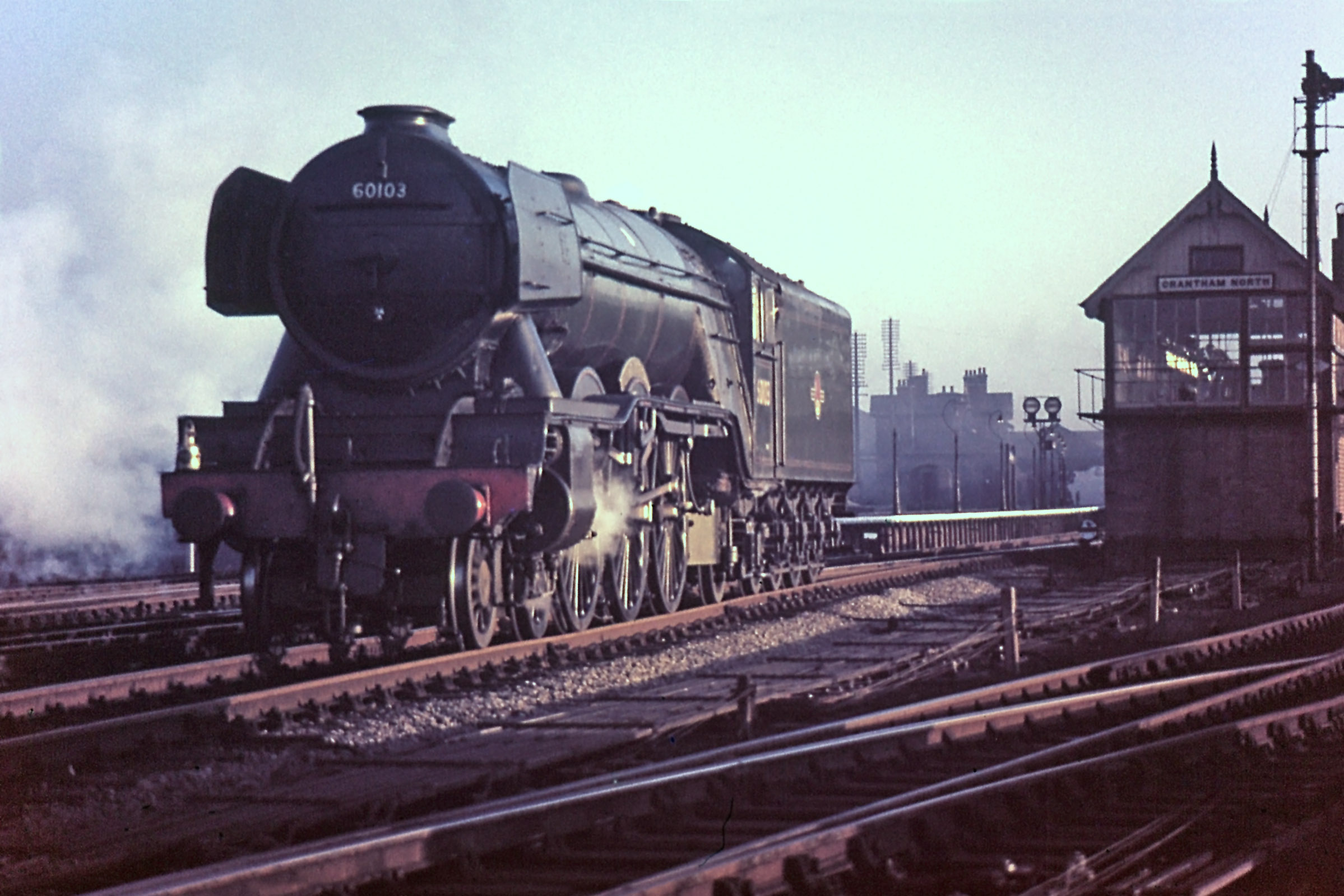
Photograph by Noel Ingram.
Regular and Relief Staff
Three regular shift Signalmen were assigned to each of the signal boxes. Before being allowed to work a signal box alone they were trained and examined in the operation of that particular box. This was over and above a general training in signalling practice, rules and regulations and the experience they brought with them from previous posts.
Boxes were graded according to the intensity and complexity of the work, and for the regular shift signalmen the rate of pay increased with the Class of their box. Promotion meant moving to a box of higher grade. The following memo to signalmen at the Yard Box shows the rates of pay for signalmen in the various Classes of box in 1921:

In 1939 the weekly wages for signalmen at the Grantham boxes were as follows:
- Grantham North (Special Class) £3.15s (75 shillings)
- Grantham South (First Class) £3.10s (70 shillings)
- Grantham Yard (Second Class) £3.5s (65 shillings)
- Barrowby Road (Fourth Class) £2.15s (55 shillings)
- Gonerby (Fourth Class) £2.15s (55 shillings)
It's interesting to note that during the 18 years between 1921 and 1939 there was no change to the rates of pay for signalmen. By 1939 the value of their wages was about 72% of what it had been in 1921. Most working people suffered financial hardship during the 1920s and 1930s, but railway signalmen had seen the value of their wages reduce by 5% more than the average.
Three regular shift Telegraph Lads worked at the North Box and three at the South Box. Each lad was assigned to the same shift pattern as one of the Signalmen so they normally worked together. Telegraph Lads’ pay was not related to the grade of the box in which they worked. In 1939 experienced Telegraph Lads at the North, South and Yard boxes were all paid £1.15s per week; those still training earned £1.10s or £1.5s.
To cover absences there were two sets of relief staff:
- Rest Day Relief (RDR) Signalmen and Telegraph Lads covered rest days;
- General Purpose Relief (GPR) staff covered holidays and sickness.
Relief Signalmen were qualified to operate several signal boxes. Because each box was different, the Relief men had to maintain a level of experience in every box they were authorised to work. They were the senior, most experienced signalmen.
Relief Signalmen were paid at the rate of the highest grade box they were qualified to work.
Rest Day Relief and General Purpose Relief tele lads earned a higher rate of pay than regular lads due to their additional box knowledge although, like the regular lads, pay was not related to the grade of the boxes they worked in.
Training for Telegraph Lads
To learn the single needle telegraph system new Telegraph Lads attended training at Lincoln. The Signalling School was at the Midland station (Lincoln St Mark’s), now gone of course and converted to a shopping centre. The training rooms are now a Lakeland shop. Trainee Signalmen also attended the school to learn signalling regulations, and the telegraph too if their box required it.
For the trainees to practice, telegraph instruments were arrange in 2 rows of about six in each row, with pairs of instruments back to back and a screen between to prevent visual contact between the sender and the receiver.
For testing the trainees the teacher, a man called Teddy Cells in the 1950s and 60s, had an instrument of his own at one end of the room linked with another at the opposite end of the room. Trainees were tested regularly by the teacher on these two instruments (observed by the rest of the class) until Teddy considered the trainee competent. The district signalling inspector would then be sent for, to carry out his examination of the trainee and to pass him fit for work in his designated box - or not, as the case may be.
The Ambulance Team
Beginning in 1893 railway employees at Grantham, including several of the signalmen, undertook ambulance training provided by the St John Ambulance Association.
Proficiency in first aid was encouraged by the GNR, the LNER and subsequently British Railways with the issue, from 1914, of an additional pass for free travel, with their family, to staff who achieved and maintained the Association's medallion standard.

The LNER, on absorption of the GNR on 1st January 1923, extended the validity of passes for free travel from the Great Northern Section to its entire network:
 The Grantham team reached a high standard of proficiency.
The Grantham team reached a high standard of proficiency.
In March 1957 the Grantham Ambulance Team achieved first place in a competition held at the headquarters of the Eastern Region of British Railways:

From The British Newspaper Archive
Image © THE BRITISH LIBRARY BOARD. ALL RIGHTS RESERVED.
In 1965 the success was repeated:
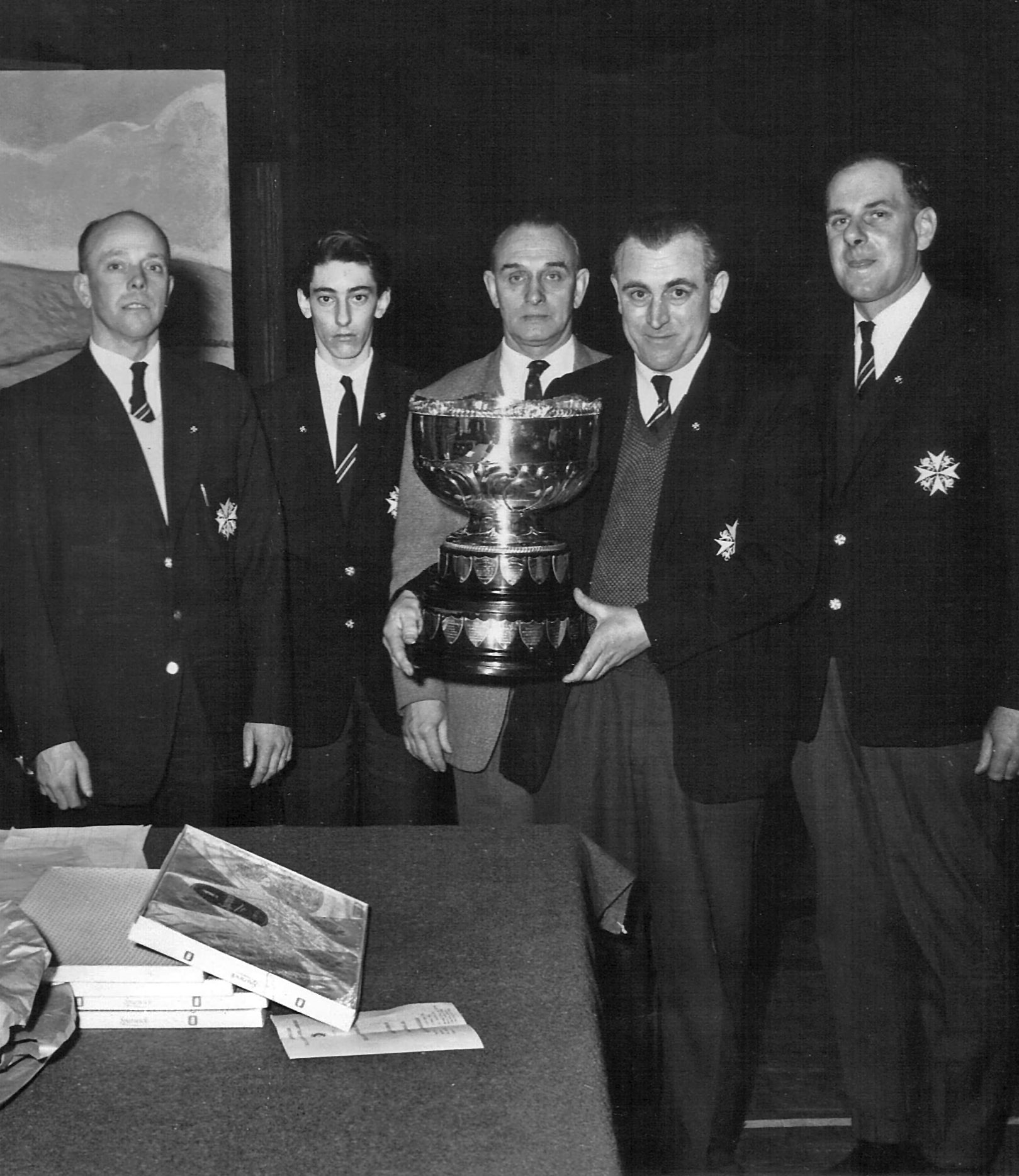
From left to right:
o Bernard Knipe, signalman at Grantham North
o David Frankish, telegraph lad at Grantham North
o Joe Booth, relief signalman
o Ron Harris, signalman at Barrowby Road, High Dyke, Honington
o Jim Drury, signalman at Barkston South (among other places)
Photograph kindly sent by Julia Lee, daughter of Joe Booth. Dad enjoyed being in the Brigade – he received an extra free travel pass! He was also in the Home Guard but not with the railway regiment.
The Bowl is certainly an impressive looking trophy. It was donated in March 1927 by Frederick Liddell Steel, President of the Great Northern Section Centre of the St John Ambulance Association, for competition between ambulance teams in, originally, the London District of the GN Section (see The LNER Magazine for May 1927, page 198). The donor was a wealthy merchant from the north west of England, who was a director of the LNER and had been deputy chairman of the GNR.
Control
Each signal box was in communication by telephone with a Train Control Office, where the overall operation of the railway was managed by a number of Controllers. The control office at King's Cross managed the East Coast Main Line and branches as far north as Barkston South Junction, where the Doncaster control office took over.
Control offices were vital hubs of communication, so both the King's Cross and the Doncaster control offices were moved to the comparative safety of the surrounding country during the second world war. The King's Cross office was based at Knebworth from 1939 until mid-1958, when it returned to King's Cross - to Floor 1 of Great Northern House. The Doncaster office moved out to Bawtry during wartime.
Equipment Installation, Maintenance and Repair: the S&T (Signals and Telegraph) Department
At the south end of the up platform was the office of the S&T Engineers, Jed Westwood and Alf Baker in the 1950s. They were responsible for managing the testing, maintenance, repair and upgrading of all the signalling and communications equipment both inside and outside the signal boxes, including in the various offices in the station and at the loco shed.
S&T Fitters and Linemen had a range of specialist skills – for example the Locking Fitter maintained and repaired signal box locking frames; others specialised in overhead line work or in signal, point and crossing gate mechanisms. The work was often in exposed locations and involved climbing tall signal posts and telegraph poles, working at height with tools and equipment while trying to hold on safely.
The men could be called out at any time to deal with local faults and failures. The memo below identifies the areas covered by the two Signal Linemen based at Grantham.

The permanent way department had a role to play in making life easier for the signalman. The regular lubrication of points is important because the lengths of rail which move across the slide chairs when points are changed are heavy – on a crossover (two points worked together) they might weigh more than a tonne. The signalman’s muscle power also had to move the heavy point rods linking the signal box lever frame with the points. Today, most points on main lines are worked by electric motor.
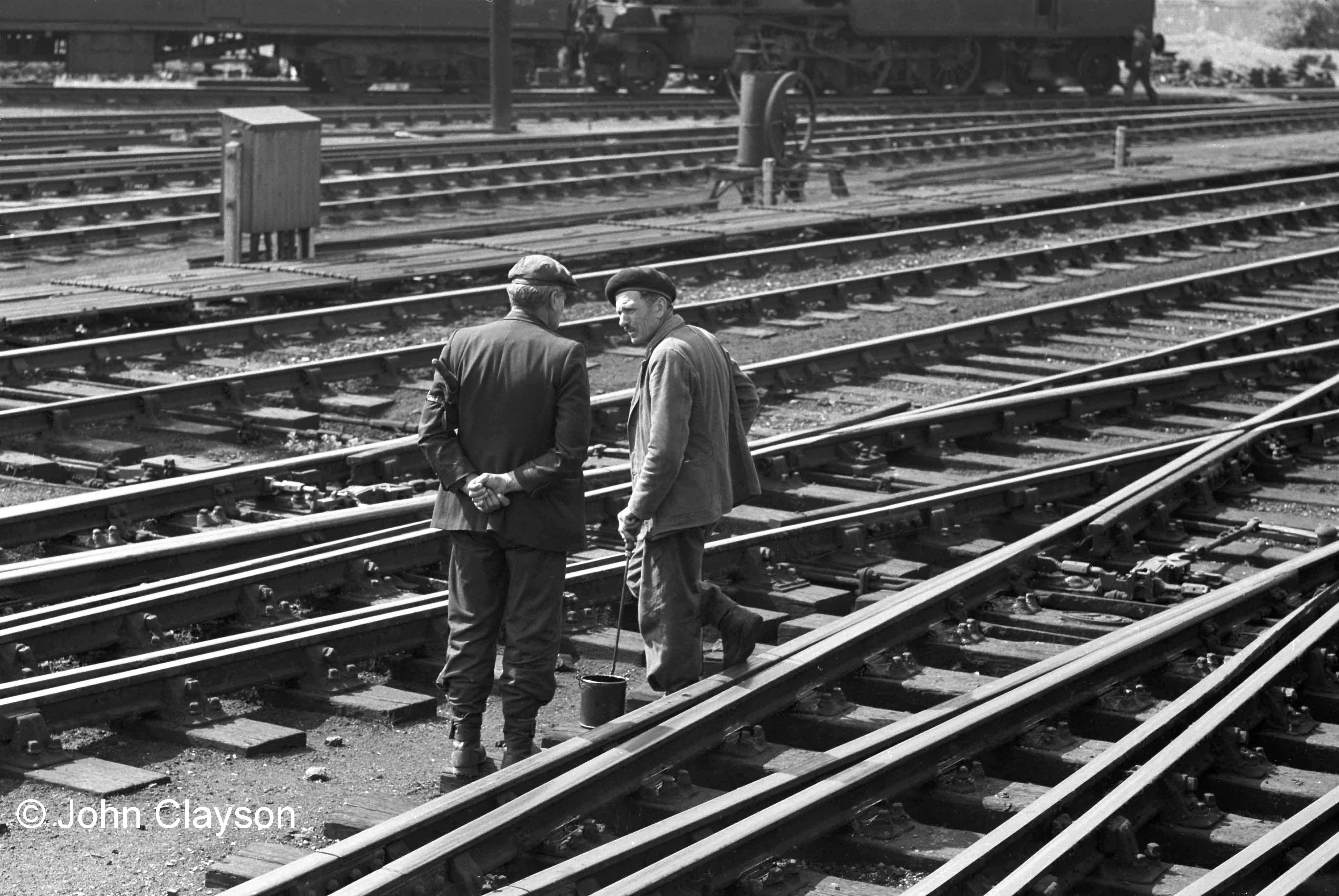
The man on the left is Tom Plummer, the North End Ganger at Grantham, who is acting as ‘Look-Out’ – he is carrying a set of flags under his left arm, on which he also has strapped an enamelled ‘Look-Out’ armband. This was, and still is, a vital role - keeping watch for, and giving warning of, approaching trains which might not be noticed by track workers engaged in a maintenance task on lines which remain open to traffic.
The object in the centre background is a drilling machine, which was used for boring holes in point stretcher bars.
May 24th 1962
Photograph by Cedric A. Clayson.
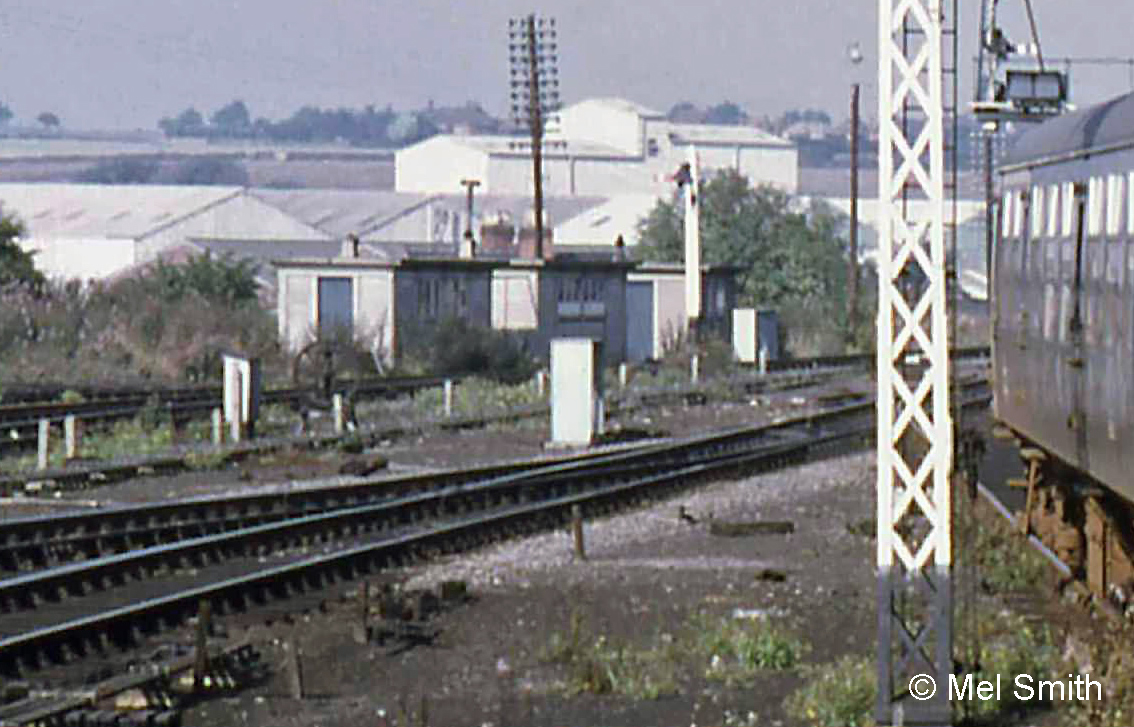
The old drilling machine is still in place, between the photographer and the door of the nearest cabin.
Photograph by Mel Smith.
Eddie Lee worked in S&T at Grantham. Julia, Eddie's wife, said "I can tell you that I have had countless nights' sleep disturbed through Eddie having to attend for various Royal Trains. Everybody, but everybody had to be on standby in the boxes and elsewhere in case of problems."
Eddie recalls this incident, probably from 1968 when Barrowby Road signal box closed:
Dave Rippon, who was in charge of arranging Sunday working, wanted the men to report for duty at 7.00 am instead of 7.30 am because they were to use a trolley on the Nottingham line at Barrowby Road, Grantham to take down a big iron lattice-work signal post. They didn't want any disruption to the main line as the Flying Scotsman was coming through. Pete Nicholls, who worked in the Carriage and Wagon department, operated an oxy-acetylene burner to cut through the base of the signal, but when it came down it fell right across the up Nottingham to Grantham line. Enquiries told them that a train had left Nottingham and was almost due. After many attempts with iron bars for leverage, the men managed to move it away from the track into the cess just in time to avoid delay.
Forward to My Early Recollections of Working on the Railway
Back to Signalling and Signal Boxes
Copyright note: the article above is published with the appropriate permissions. For information about copyright of the content of Tracks through Grantham please read our Copyright page.

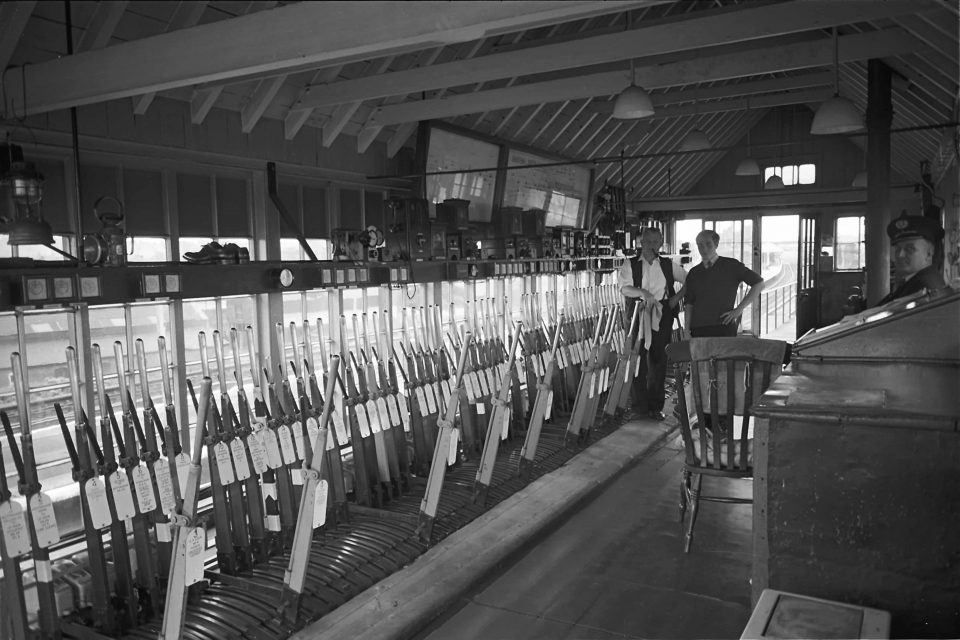
I started at Grantham station in 1950 in various departments and remember the Yard Box had a telegraph lad as well as the signalman. I worked in Grantham North before national service took me away, returning to Barrowby Road box and Stoke box.
That's very helpful. We knew there were telegraph lads employed at the Yard Box in 1939 because they are listed and identified in a record of the staff at Grantham station. We also think that by the late 1950s/early 1960s the Yard Box signalmen normally worked alone. I was allowed into the Yard Box on a few occasions in the early 1960s and I'm sure there was only the signalman there. It seems, then, that the change took place during the second half of the 1950s. At around this time I believe the connection at the Yard Box into the Up side goods yard was taken out. Perhaps this and other reductions in the workload there, notably fewer engine changes from the mid-1950s onward, meant that the telegraph lads were dispensed with. Does anyone know?
I'll drop you an email separately about Barrowby Road as I have still to write its pages.
That is a fantastic picture of the inside of Grantham North with the Signalman and Telegraph Lad. I was lucky enough to know the signalman, when I was a relief telegraph lad h/s Peterborough North, Mr Albert Eldridge who was one of nature's gentlemen. He was on the same shift when I was relieving the Telegraph Lad at Grantham South under the supervision of Mr Tom Charity
Those were great days when you thought the life would never alter and go on for ever. Is it possible to purchase a copy of this picture as it brings back so many good memories.
Hello John,
Thank you for getting in touch. It's always a pleasure to hear from people who experienced working in the signal boxes in and around Grantham. I'll reply to you separately about the photograph.
Best wishes,
John Clayson
Hi, The signalman in the photo of North Box is Albert Eldridge. I was a telegraph lad in North Box from 1967-69 and worked with Albert many times. He was a gentleman and a pleasure to work with. He did love a pipe of St Bruno! There were only two lads at North Box when I was there so we worked 12hr shifts, which meant I worked with all three signalmen. The other two were Bernard Knipe and Les Keily.